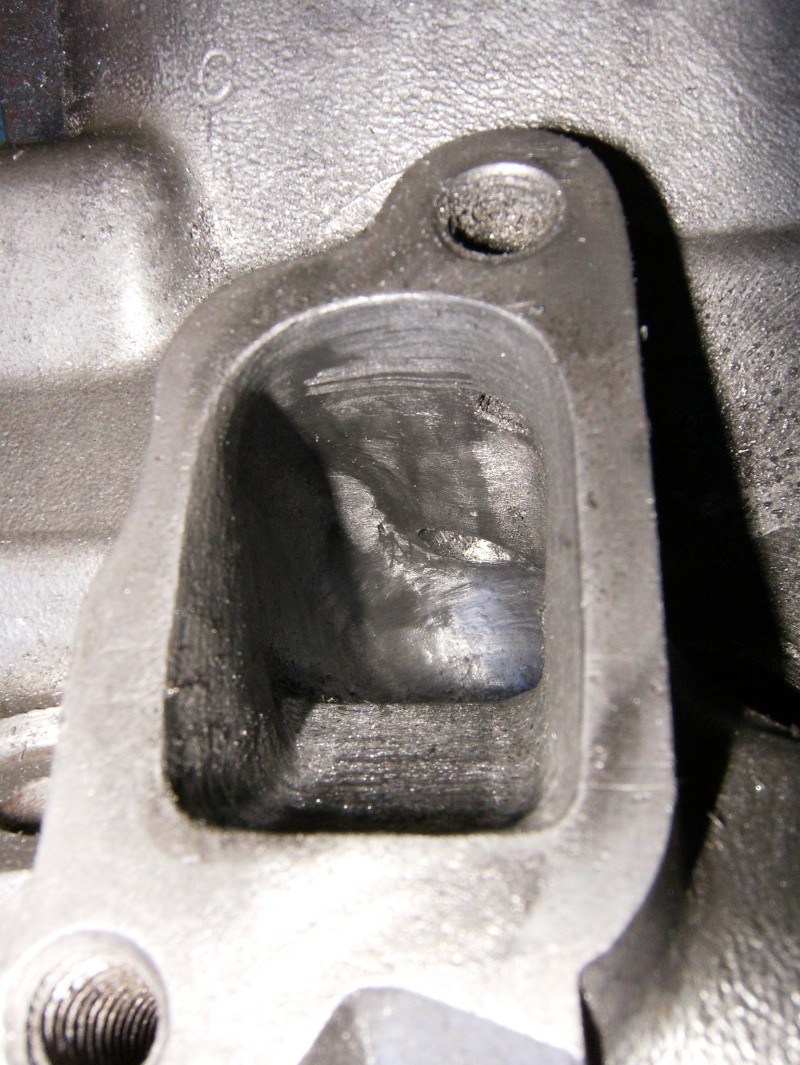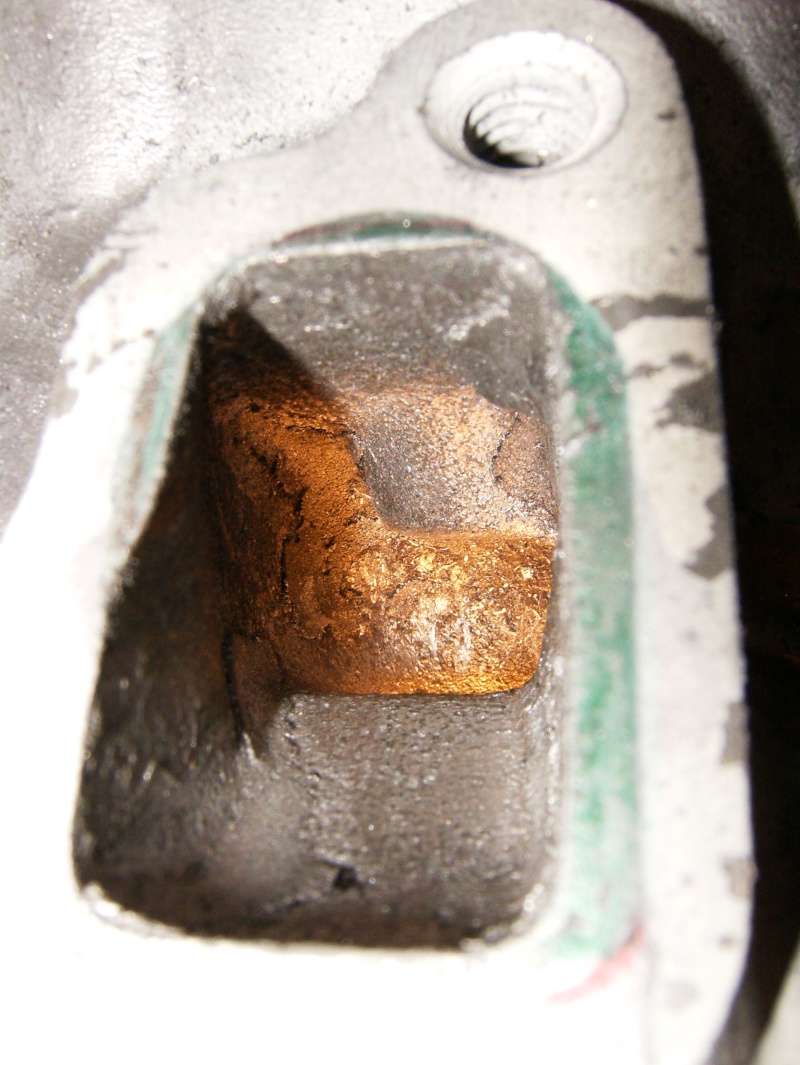Page 1 of 1
D-shaped Exhaust Ports
Posted: Tue Mar 04, 2008 3:39 pm
by Wotland
Hello,
The exhaust ports of my pair of Buick 300 heads have been D-Shaped to help to prevent reversion on the overlap phase of the camshaft timing.

But generally the ports of exhaust manifolds are rectangular. So there is an benefice to D-Shape it also ?
I recently buy an pair of Dakar cast exhaust manifolds and there is plenty of material around the port to D-shaped it.
They are really big by comparaison of standard Range Rover cast Ex. manifolds

Cheers.
Posted: Wed Mar 05, 2008 8:53 pm
by CastleMGBV8
I believe we are talking about two seperate issues. I am not an expert but from what I ve read the reason for creating the arched roof to the exhaust port is purely to improve flow by raising the height of the port and the arch is just a convenient shape.
Anti reversion is another matter and can be quite complicated, the simplest method is to have the primaries slightly larger than the port size which give a pressure drop as the gasses exit the cylinder head and a step to further hold back the gasses.
More complex methods on some headers I've seen is a second tube inside the even larger primaries, I can only assume that this is meant to further resist a pressure wave tring to re-enter the port and would love to learn more about the principle.
Kevin.
Posted: Wed Mar 05, 2008 9:09 pm
by CastleMGBV8
And I thought legalese was painful.
United States Patent 6336471
Inventors: Feuling; James J. (686 Ash Ave., Chula Vista, CA 92010)
Abstract:
An improved fluid flow system for enhancing fluid flow through an opening. The first embodiment uses a first extension member for extending an opening through a perpendicular surface and a second extension member with a generally converging introductory section secured in a sealed overlapping relationship to the distal end of the first extension member. A second embodiment uses a pair of conduits of equal cross-section with a bulbous section therebetween with one of the conduits inserted into the bulbous section. A third embodiment with unequal cross-sections with the smaller diameter conduit inserted into the larger diameter conduit and sealed thereto for forming a continuous conduit.
That's the patent that Hytech is using under license.
From Hytech's site:
There is a useful diagram which didn't print so heres a link to the site and some nice pictures of headers.
Just scroll down the page.
http://www.honda-tech.com/zerothread?id=1161501
Kevin.
Posted: Thu Mar 06, 2008 1:39 pm
by Wotland
Hello Kevin,
As I know D port has been developped first by Pontiac in early 50's.
The "D" shaped exhaust port is designed to provide a larger area for increased flow and velocity as well as to create a mismatch between the exhaust pipe and the exhaust exit. This purpose-built mismatch reduces "power robbing" reversion by keeping the majority of the exhaust gasses from going back into the engine.
In fact what's I am looking for is how to estimate the good mismatch between head and exhaust manifold.
Just keep the port of manifold rectangular and the mismatch is only on the ''top'' of the D or do I need also to D-shaped the port of manifold but jut an little larger than head exhaust port and have an general mismatch all around the exhaust port. Sorry it is an bite difficult for me to explain in english my idea

.
Posted: Thu Mar 06, 2008 7:35 pm
by CastleMGBV8
I think considering you are using a foreign language that you explained it very well.
I wish I could be more helpful, I believe you have the principal correct and the only way to achieve it would be some purpose made manifolds with the anti reversion built in. I found quite a lot of links to this subject by doing a Google search, could be worth speding a bit of time seeing what others have done.
I'm also using a pair of Buick 300 heads on my new 4.35 engine, i'm leaving the ports stock, they have enough flow for my purposes just a bit of cleaning up, bulletting the guides and a new set of 1.63" inlets and 1.4" waisted stem valves should do the job.
Looking at the picture of your exhaust port the machining seems to have gone into the thread for the manifold bolt and there appears to be another hole further into the port, how are you going to repair them?
Kevin
Posted: Thu Mar 06, 2008 7:58 pm
by sidecar
One of fourstroke tuning books that I've got (by A. Graham Bell!) reckons that at low RPM the main flow of exhaust gas is along the floor of the port therefore if the step is created there it will improve the bottom end. At high RPM the flow is along the roof, a step there improves BHP around peak revs.
I lot of motorbike engines seem to have the setp all the way round the port.
Pete
Posted: Fri Mar 07, 2008 4:02 pm
by Wotland
CastleMGBV8 wrote:
Looking at the picture of your exhaust port the machining seems to have gone into the thread for the manifold bolt and there appears to be another hole further into the port, how are you going to repair them?
Kevin
Thank you for compliment on my english

.
I use 1.5'' Ferrea exhaust valves and 1.775'' Ferrea inlet valves.
This pair of heads is destined to an 4.4 supercharged.
Picture has been taken just after first porting step.
During porting we have gone into the thread for manifold bolt. The problem is the thread in head is very deep. If you look an standard port you can see an little extension in casting for the deep thread.
But it is not an problem as we will use exhaust manifold studs. An small aluminium insert has been done to obstruct inside the thread the small hole at the end of the thread.
The floor has been welded and machined to be completly flat in view to raise an little the exhaust port.

The hole in the back is the for the bronze valve guide not yet installed on the picture.
Posted: Fri Mar 07, 2008 9:47 pm
by CastleMGBV8
Sounds an interesting project, can't wait to learn how it performs,
Kevin.
Posted: Fri Mar 07, 2008 10:47 pm
by Pocket rocket
Just so that I'm clear on this "step" issue - should the port be bigger than the manifold or the other way round?
Posted: Fri Mar 07, 2008 11:08 pm
by HairbearTE
The manifold should be bigger than the port.
Posted: Sat Mar 08, 2008 7:01 am
by kiwicar
Very nice work.
Mike
Posted: Sat Mar 08, 2008 8:27 am
by sidecar
Pocket rocket wrote:Just so that I'm clear on this "step" issue - should the port be bigger than the manifold or the other way round?
The header should be bigger than the exhaust port, the idea is that it helps stop exhaust gas reversion back into to cylinder.
As RV8 ports are square and most headers are round tube it is possibe to create the step and the back of the header flanges by welding the round tube to the back of the flange without first flaterning the tube into a square section.
Pete
Posted: Sat Mar 08, 2008 10:15 am
by Wotland
Thank you again for yours compliments.
Picture of the port before we start to play with porting :

Yesterday I checked on Yahoo and in USA there are special D-shaped exhaust tube manifolds (last Ford Mustang for exemple) when you have D-shaped exhaust port. They don't speak of mistmatch between manifold and exhaust port.
Posted: Sat Mar 08, 2008 3:23 pm
by CastleMGBV8
If you look at the diagram in the link in my earlier posting you can see an extreme example of anti-reversion.
I think it may also have been described in the past as scavenging and pressure wave tuning especially in two stroke engines.
If you are supercharging the engine and using a low overlap cam it will be less important.
What bottom end are you using P76?
Kevin.
Posted: Sun Mar 09, 2008 5:01 pm
by Wotland
CastleMGBV8 wrote:
What bottom end are you using P76?
Kevin.
Yes the Terrier short block with his forged crank but heavily modified with block sump girdle, Crower forged rods, and Omega forged pistons.





